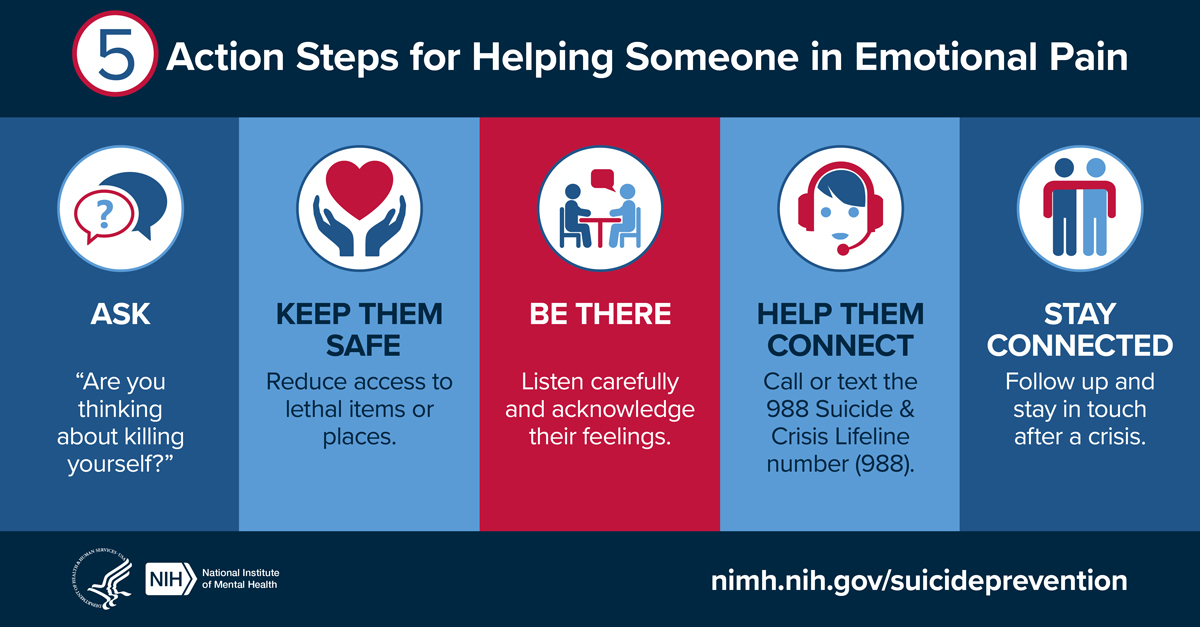Suicide is one of the leading causes of death in the United States. It is the second leading cause of death for people aged 10 to 34. The highest rate of suicide occurs in persons 75 years of age or older. The impact of suicide in communities makes suicide a serious public health problem.
In 2022 in the U.S., more than 49,000 people died by suicide and an there were an estimated 1.7 million people attempted suicide (2021) according to the Centers for Disease Control and Prevention (CDC). This is one death by suicide every 11 minutes.1 Men were more than three times more likely than women to take their lives. Firearms are the most common method of suicide (used in about half of all suicides).
Yet, suicide is preventable. Knowing the risk factors and recognizing the warning signs for suicide can help prevent suicide.
Suicide is linked to mental disorders, particularly depression and alcohol use disorders, and the strongest risk factor for suicide is a previous suicide attempt. The Suicide Prevention Resource Center defines risk and protective factors and warning signs:
- Risk factors are characteristics that make it more likely that an individual will consider, attempt or die by suicide.
- Warning signs indicate an immediate risk of suicide.
- Protective factors are characteristics that make it less likely that individuals will consider, attempt or die by suicide.
Risk Factors
Individual, relationship, community and societal factors can increase the risk of suicide such as:
- Previous suicide attempt(s).
- A history of suicide in the family.
- Substance use.
- Mood disorders (depression, bipolar disorder).
- Access to lethal means (for example, keeping firearms in the home or having access to unsecured prescription medications)
- Losses and other events (for example, the breakup of a relationship or a death, academic failures, legal difficulties, financial difficulties).
- History of trauma or abuse.
- Bullying.
- Chronic physical illness, including chronic pain.
- Exposure to the suicidal behavior of others.
- Social isolation.
- Historical trauma.
- Stigma associated with seeking help.
In some cases, a recent stressor or sudden catastrophic event, failure or can leave people feeling desperate, unable to see a way out, and become a "tipping point" toward suicide.
A CDC report highlights the complexity of suicide.2 While a mental health condition may be a contributing factor for many people, many factors contribute to suicide among people with and without known mental health conditions. A relationship problem was the top factor contributing to suicide, followed by crisis in the past or upcoming two weeks and problematic substance use. About half, 54 percent, of people who died by suicide did not have a known mental health condition, according to CDC.3 However, many of them may have been dealing with mental health challenges that had not been diagnosed or known to those around them.
Warning Signs
- Often talking or writing about death, dying or suicide.
- Making comments about being hopeless, helpless or worthless.
- Expressions of having no reason for living; no sense of purpose in life; saying things like "It would be better if I wasn't here" or "I want out."
- Increased alcohol and/or drug use.
- Withdrawal from friends, family and community.
- Reckless behavior or more risky activities, seemingly without thinking.
- Dramatic mood changes.
- Talking about feeling trapped or being a burden to others.
Protective Factors
- Contacts with providers (such as, follow-up phone call from health care professional).
- Effective mental health care; easy access to a variety of clinical interventions.
- Feelings of strong connections to individuals, family, community and social institutions.
- Strong sense of cultural identity.
- Problem-solving and conflict resolution skills.
The CDC recommends a comprehensive public health approach to suicide prevention and it identifies several strategies that states and communities can undertake, including such measures as teaching coping and problem-solving skills to help people manage challenges, expanding options for temporary assistance for those in need and connecting people at-risk to effective and coordinated mental and physical health care.
What You Can Do
988 Suicide Crisis and Lifeline has developed five steps to take to support a loved one that may be experiencing suicidal thoughts. >
- Ask someone you are concerned about if they're thinking about suicide. Studies show that asking someone if they are having thoughts of suicide does not increase the likelihood of a completed suicide nor does it increase suicidal thoughts.
- Be there for them. This could be by phone or in person.
- Keep them safe. Reduce access to lethal means for those at risk.
- Help them connect with ongoing support.
- Follow up. Give them a call or visit. Send a text or an email to let them know that you are still present.
Learn more and find resources at www.BeThe1To.com. Be the one to save a life. You can do something to prevent suicide.
If you need help for yourself or someone else, contact the Suicide and Crisis Lifeline by calling or texting 988. You can also chat online at 988lifeline.org.

- Centers for Disease Control and Prevention. 2023. Suicide Data and Statistics.
- CDC. 2018. Fact Sheet: Suicide Rising Across the U.S. (.pdf)
- Centers for Disease Control and Prevention. Stone, et al. Vital Signs: Trends in State Suicide Rates – United States, 1999-2016 and Circumstances Contributing to Suicide – 27 States, 2015. Morbidity and Mortality Weekly Report. June 8, 2018. Vol.67, No.22.
Physician Review
Monica Taylor-Desir, M.D., M.P.H.,
Member, APA Council on Communications
February 2023
